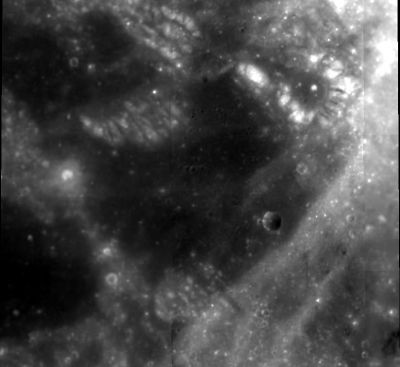Difference between revisions of "Lacus Hiemalis"
| Line 1: | Line 1: | ||
<div id="content_view" class="wiki" style="display: block"> | <div id="content_view" class="wiki" style="display: block"> | ||
=Lacus Hiemalis= | =Lacus Hiemalis= | ||
| − | ''(current [ | + | ''(current [[IAU|IAU]] name; former IAU name: '''[[Menelaus|Menelaus]] R''')''<br /> |
{| class="wiki_table" | {| class="wiki_table" | ||
| | | | ||
| − | Lat: 15.0°N, Long: 14.0°E, Diam: 50 km, Depth: km, [ | + | Lat: 15.0°N, Long: 14.0°E, Diam: 50 km, Depth: km, [[R%C3%BCkl%2023|Rükl 23]]<br /> |
|} | |} | ||
<div id="toc"> | <div id="toc"> | ||
| Line 12: | Line 12: | ||
[http://www.lpod.org/coppermine/thumbnails.php?album=search&type=full&search=Lacus%20Hiemalis LPOD Photo Gallery] [http://www.lpi.usra.edu/resources/lunar_orbiter/bin/srch_nam.shtml?Lacus%20Hiemalis%7C0 Lunar Orbiter Images] [http://www.lpi.usra.edu/resources/apollo/search/feature/?feature=Lacus%20Hiemalis Apollo Images]<br /> Apollo 17's oblique south-looking ''Fairchild'' camera photograph [http://www.lpi.usra.edu/resources/apollo/frame/?AS17-M-1666 AS17-M-1666] shows '''Lacus Hiemalis''' and adjacent '''Daubrée''' slightly leftward of the frame's centre.<br /> Research Danny Caes<br /> <br /> | [http://www.lpod.org/coppermine/thumbnails.php?album=search&type=full&search=Lacus%20Hiemalis LPOD Photo Gallery] [http://www.lpi.usra.edu/resources/lunar_orbiter/bin/srch_nam.shtml?Lacus%20Hiemalis%7C0 Lunar Orbiter Images] [http://www.lpi.usra.edu/resources/apollo/search/feature/?feature=Lacus%20Hiemalis Apollo Images]<br /> Apollo 17's oblique south-looking ''Fairchild'' camera photograph [http://www.lpi.usra.edu/resources/apollo/frame/?AS17-M-1666 AS17-M-1666] shows '''Lacus Hiemalis''' and adjacent '''Daubrée''' slightly leftward of the frame's centre.<br /> Research Danny Caes<br /> <br /> | ||
==Maps== | ==Maps== | ||
| − | ''([ | + | ''([[LAC%20zone|LAC zone]] 60A1)'' [http://www.lpi.usra.edu/resources/mapcatalog/LAC/lac60/ LAC map] [http://www.lpi.usra.edu/resources/mapcatalog/usgs/I510/ Geologic map] [http://www.lpi.usra.edu/resources/mapcatalog/LM/lm60/ LM map] [http://www.lpi.usra.edu/resources/mapcatalog/LTO/lto60a1_1/ LTO map]<br /> <br /> |
==Description== | ==Description== | ||
'''Lacus Hiemalis''' is probably one of the most unknown (or less known) officially named low-albedo regions on the moons surface. Thanks to crater '''Daubrée''' at its northeastern border (and the curious "''bright broken ring''" appearance of it during high solar illumination) this lunar lake is quite easily detectable through all sorts of telescopes.<span class="membersnap">- [http://www.wikispaces.com/user/view/DannyCaes [[Image:DannyCaes-lg.jpg|16px|DannyCaes]]] [http://www.wikispaces.com/user/view/DannyCaes DannyCaes] <small>Aug 9, 2013</small></span><br /> <br /> <br /> | '''Lacus Hiemalis''' is probably one of the most unknown (or less known) officially named low-albedo regions on the moons surface. Thanks to crater '''Daubrée''' at its northeastern border (and the curious "''bright broken ring''" appearance of it during high solar illumination) this lunar lake is quite easily detectable through all sorts of telescopes.<span class="membersnap">- [http://www.wikispaces.com/user/view/DannyCaes [[Image:DannyCaes-lg.jpg|16px|DannyCaes]]] [http://www.wikispaces.com/user/view/DannyCaes DannyCaes] <small>Aug 9, 2013</small></span><br /> <br /> <br /> | ||
| Line 20: | Line 20: | ||
<br /> | <br /> | ||
==Nomenclature== | ==Nomenclature== | ||
| − | * The [ | + | * The [[IAU|IAU]] name is Latin for "Wintry Lake". |
| − | * This name was not part of the original [ | + | * This name was not part of the original [[IAU%20nomenclature|IAU nomenclature]]. Instead it is one of 120 names appearing on NASA's [[LTO|LTO]] charts that were approved by the [[IAU|IAU]] in [http://the-moon.us/wiki/IAU%20Transactions%20XVIB 1976]. It is said there to replace '''[[Menelaus|Menelaus]] R''', a name that had been added in the ''[[System%20of%20Lunar%20Craters|System of Lunar Craters]]''. |
<br /> | <br /> | ||
==LPOD Articles== | ==LPOD Articles== | ||
Revision as of 16:00, 15 April 2018
Contents
Lacus Hiemalis
(current IAU name; former IAU name: Menelaus R)
|
Lat: 15.0°N, Long: 14.0°E, Diam: 50 km, Depth: km, Rükl 23 |
Table of Contents

Clementine
Lacus Hiemalis (centre) and Daubrée at its northeastern border, an incomplete crater which looks like some sort of "bright broken ring" during high solar illumination.- DannyCaes DannyCaes Aug 9, 2013
Images
LPOD Photo Gallery Lunar Orbiter Images Apollo Images
Apollo 17's oblique south-looking Fairchild camera photograph AS17-M-1666 shows Lacus Hiemalis and adjacent Daubrée slightly leftward of the frame's centre.
Research Danny Caes
Maps
(LAC zone 60A1) LAC map Geologic map LM map LTO map
Description
Lacus Hiemalis is probably one of the most unknown (or less known) officially named low-albedo regions on the moons surface. Thanks to crater Daubrée at its northeastern border (and the curious "bright broken ring" appearance of it during high solar illumination) this lunar lake is quite easily detectable through all sorts of telescopes.- DannyCaes DannyCaes Aug 9, 2013
Description: Wikipedia
Additional Information
Nomenclature
- The IAU name is Latin for "Wintry Lake".
- This name was not part of the original IAU nomenclature. Instead it is one of 120 names appearing on NASA's LTO charts that were approved by the IAU in 1976. It is said there to replace Menelaus R, a name that had been added in the System of Lunar Craters.
LPOD Articles
Bibliography
This page has been edited 1 times. The last modification was made by - tychocrater tychocrater on Jun 13, 2009 3:24 pm - afx3u2